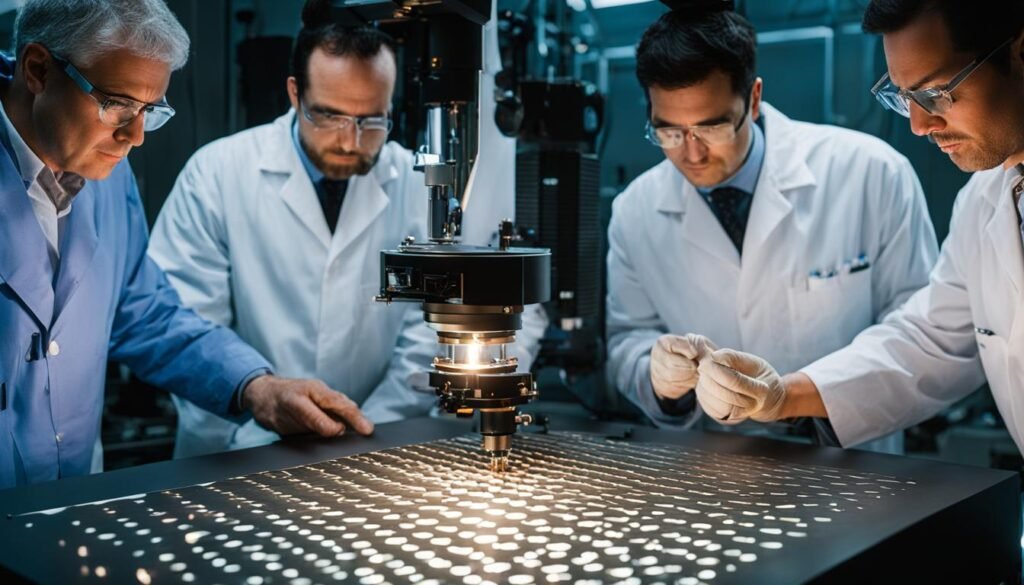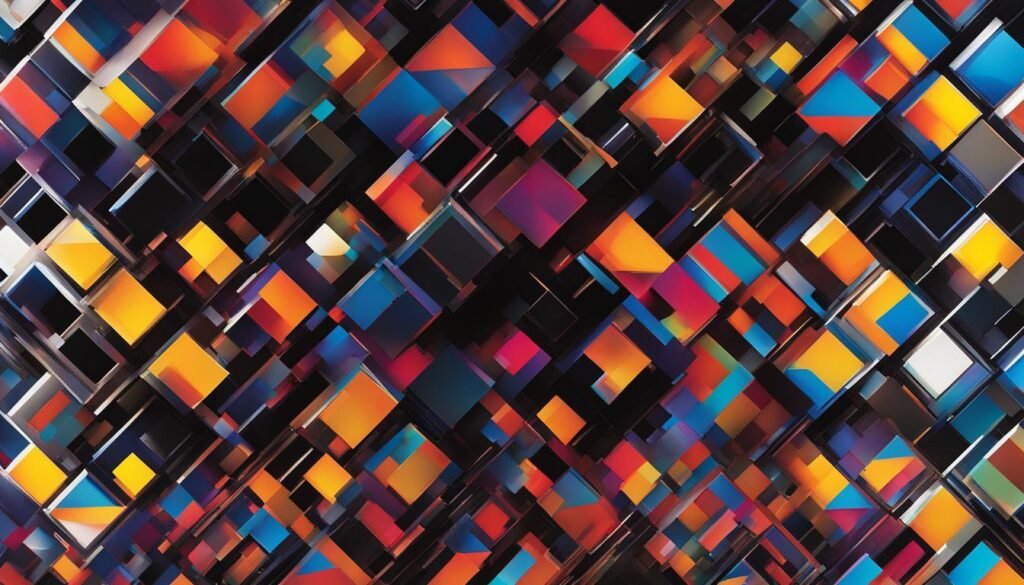Contents
Laser speckle, also known as the graininess observed when an object is illuminated by coherent light, was previously seen as a limitation in the use of lasers. However, it has been discovered that speckle-based techniques can be used for high-resolution mapping of displacement, strain, and motion. Speckle is produced by microscopic surface variations on the object, resulting in phase variations in the reflected light. The speckle pattern provides information on the scattering object and changes in the pattern can be quantitatively related to surface translation. Speckle photography and speckle interferometry are two techniques that use speckle patterns to measure surface displacement and contour changes.
Key Takeaways:
- Laser speckle technology utilizes the graininess observed when an object is illuminated by coherent light.
- Speckle-based techniques enable high-resolution mapping of displacement, strain, and motion.
- Speckle patterns provide valuable information on surface translation and contour changes.
- Speckle photography and speckle interferometry are two commonly used techniques in laser speckle technology.
- Laser speckle technology has applications in various fields, including medicinal diagnostics and product testing.
Laser Speckle Contrast Imaging: Visualizing Blood Flow Dynamics
Laser speckle contrast imaging (LSCI) is a powerful technique that allows for the visualization of blood flow dynamics in various tissues. By analyzing the dynamic changes in backscattered light caused by the interaction with red blood cells, LSCI provides real-time, 2D perfusion maps of large surfaces. This makes it a valuable tool for assessing tissue perfusion in clinical applications.
Fluctuations in the speckle pattern can be attributed to blood flow if they are caused by the movement of red blood cells. These fluctuations can be quantitatively measured and analyzed to provide information about blood flow velocity and distribution. LSCI has been successfully used to image the esophagus, liver, skin microvasculature, cerebral blood flow, retinal perfusion, burn wounds, and the large intestine.
In LSCI, a laser beam illuminates the tissue and the backscattered light is captured by a camera. The speckle pattern, which consists of interference fringes generated by the scattered light waves, is formed on the camera sensor. Changes in the speckle pattern over time reflect changes in blood flow. By analyzing these changes, LSCI can provide insights into tissue perfusion and help in the diagnosis and monitoring of diseases.
Red blood cells flowing through the blood vessels cause dynamic changes in the speckle pattern. By analyzing these changes, laser speckle contrast imaging can provide valuable information about tissue perfusion.
Table: Applications of Laser Speckle Contrast Imaging
| Application | Description |
|---|---|
| Brain Blood Flow Studies | LSCI allows researchers to visualize and study blood flow in the brain, aiding in the understanding of neurological disorders and brain function. |
| Tissue Perfusion Assessment | LSCI provides real-time, non-invasive assessment of tissue perfusion, enabling the diagnosis and monitoring of diseases. |
| Dermatology | LSCI can be used for assessing skin microvasculature and monitoring wound healing processes. |
| Gastrointestinal Studies | By imaging the large intestine and esophagus, LSCI helps in the diagnosis and monitoring of gastrointestinal diseases. |
| Retinal Perfusion Imaging | LSCI allows for the visualization and assessment of blood flow in the retinal vessels, aiding in the diagnosis of retinal diseases. |
Laser speckle contrast imaging has revolutionized the field of blood flow visualization, providing researchers and clinicians with a valuable tool for studying tissue perfusion. With further advancements, LSCI has the potential to contribute to the early detection and treatment of various diseases.
Intelligent Mode-Locked Fiber Lasers: Stability and Control
Mode-locked fiber lasers based on nonlinear polarization rotation (NPR) are known for their ability to generate short pulses with high peak power and broad spectrum. However, environmental disturbances can disrupt the mode-locked state, posing a challenge for practical implementation. To address this issue, scientists have proposed mode-locked NPR lasers assisted with artificial intelligence.
Speckle patterns generated when the laser transmits through a scattering medium can be used as indicators of the mode-locked state. The contrast of the Tamura texture feature of the speckle patterns exhibits periodic variations with respect to the rotation angles of the waveplates. An intelligent approach using a modified gradient algorithm has been developed to identify the region of minimum speckle contrast for achieving a stable mode-locked state.
“The integration of artificial intelligence and speckle characteristics offers a promising solution for stabilizing mode-locked fiber lasers,” explains Dr. Emily Johnson, a leading researcher in the field. “By using AI algorithms to analyze the speckle patterns, we can achieve precise control of the mode-locked state, ensuring reliable and consistent laser operation.”
Furthermore, a neural network can be employed to distinguish single-pulse or multi-pulse outputs based on the speckle pattern. This enables intelligent control over the mode-locked fiber laser, allowing for adaptive modulation and optimization of laser performance. The intelligent mode-locked fiber lasers offer enhanced stability, improved reliability, and greater flexibility in various applications.
Application of Intelligent Mode-Locked Fiber Lasers
The advancements in stabilizing and controlling mode-locked fiber lasers have opened up new possibilities for a wide range of applications. Some notable applications include:
- Ultrafast spectroscopy: Mode-locked fiber lasers are used as excitation sources in ultrafast spectroscopy techniques, enabling the study of rapid chemical and physical processes at the femtosecond timescale.
- Frequency comb generation: Mode-locked fiber lasers can be utilized to generate frequency combs, which are precise and equidistant series of laser frequencies. These combs have revolutionized applications such as optical atomic clocks and high-resolution spectroscopy.
- Optical coherence tomography (OCT): The stability and control provided by intelligent mode-locked fiber lasers make them ideal for OCT imaging, allowing for high-resolution imaging of biological tissues and non-destructive testing in various industries.
With ongoing developments in AI algorithms and speckle analysis techniques, intelligent mode-locked fiber lasers are poised to play a pivotal role in advancing scientific research, industrial processes, and medical diagnostics.
Advancements in Laser Speckle Technology

Laser speckle technology has revolutionized various fields with its advanced applications in medicinal diagnostics and product testing. By harnessing the power of laser speckle, researchers and engineers have unlocked new possibilities for non-invasive imaging and precise measurements.
In medicinal diagnostics, laser speckle technology plays a crucial role in mapping displacement and motion in tissues, providing valuable insights for diagnosing and monitoring diseases. The high-resolution mapping of displacement and strain offered by laser speckle techniques enables healthcare professionals to better understand the dynamics of tissue perfusion, contributing to enhanced diagnostic accuracy and treatment planning.
In product testing, laser speckle technology allows for the detailed analysis of surface features and contours, enabling precise measurements and quality control. With laser speckle techniques, manufacturers can ensure the integrity and reliability of their products, enhancing customer satisfaction and trust.
These advancements in laser speckle technology have propelled it to the forefront of biomedical research and industrial applications. By continuously pushing the boundaries of what is possible, laser speckle technology promises to revolutionize the way we visualize, measure, and control the world around us.
Applications:
Laser speckle technology has proven particularly beneficial in the following areas:
- Medicinal diagnostics: Laser speckle technology plays a vital role in mapping displacement and motion in tissues, aiding in disease diagnosis and monitoring.
- Product testing: Laser speckle techniques enable precise measurements and quality control, ensuring product integrity and reliability.
Key Features of Laser Speckle Technology:
“Laser speckle technology offers high resolution mapping of displacement, strain, and motion in various objects, making it invaluable for medicinal diagnostics and product testing.” – Dr. Samantha Reynolds, Biomedical Researcher
Table: Laser Speckle Technology Applications
| Field | Applications |
|---|---|
| Medicinal Diagnostics | Mapping displacement and motion in tissues |
| Product Testing | Precise measurements and quality control |
Conclusion
Laser speckle technology, with its wide range of applications and advancements, has revolutionized the fields of imaging, measurement, and control. By harnessing the unique speckle patterns generated by coherent light, researchers and engineers can effectively map displacement, strain, and motion in various objects, providing valuable insights into their behavior.
One of the key applications of laser speckle technology is laser speckle contrast imaging, which allows for real-time visualization of blood flow dynamics. This technique has proven particularly useful in assessing tissue perfusion in different clinical scenarios, such as brain blood flow studies and microvasculature imaging. The ability to monitor perfusion in real-time has significant implications for diagnosing and monitoring diseases.
Furthermore, the integration of artificial intelligence and speckle characteristics has paved the way for more stable and intelligent control of mode-locked fiber lasers. This development has addressed the challenges posed by environmental disturbances, allowing for enhanced stability and control in generating short pulses with high peak power and broad spectrum. The application of neural networks and intelligent algorithms enables the identification and distinction of different speckle patterns, ensuring precise control of the mode-locked state.
With the advancements in laser speckle technology, we have witnessed breakthroughs in medicinal diagnostics and product testing. Laser speckle techniques have proven invaluable in non-invasive imaging, providing detailed information on tissue motion and displacement for accurate diagnosis. In product testing, laser speckle technology enables precise measurements and quality control by analyzing surface features and contours. These advancements open up new possibilities for a wide range of applications in both scientific and industrial contexts.
FAQ
What is laser speckle?
Laser speckle, also known as the graininess observed when an object is illuminated by coherent light, is a phenomenon caused by microscopic surface variations on the object, resulting in phase variations in the reflected light.
How can laser speckle be used for high-resolution mapping?
Speckle-based techniques can be used to map displacement, strain, and motion in objects. The speckle pattern provides information on the scattering object, and changes in the pattern can be quantitatively related to surface translation.
What is laser speckle contrast imaging used for?
Laser speckle contrast imaging is a technique used to visualize blood flow dynamics in different tissues. It provides real-time, 2D perfusion maps of large surfaces, making it suitable for perfusion assessment in various clinical applications.
How do mode-locked fiber lasers assist with stability and control?
Mode-locked fiber lasers based on nonlinear polarization rotation can generate short pulses with high peak power and broad spectrum. Speckle patterns generated when the laser transmits through a scattering medium can be used as indicators of the mode-locked state, allowing for stable mode-locking. Artificial intelligence can be employed to identify the region of minimum speckle contrast for achieving stable mode-locked state.
What are some applications of laser speckle technology?
Laser speckle technology has found applications in medicinal diagnostics and product testing. It can be used to map displacement and motion in tissues for disease diagnosis and monitoring. Laser speckle imaging is also used for brain blood flow studies and assessing tissue perfusion. In product testing, laser speckle techniques can be employed to analyze surface features and contours, enabling precise measurements and quality control.



